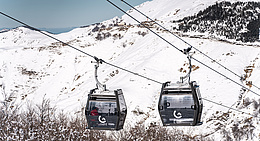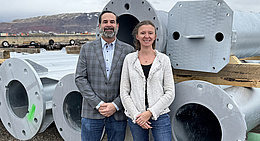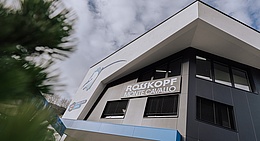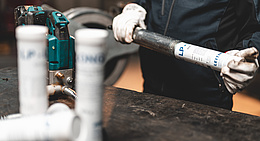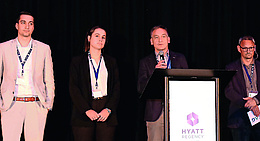There have been several articles on the innovative engineering and design employed for Stanserhorn’s new jigback in previous numbers of ISR. Often enough, the accolade “a world first” is employed for details which, although new, are not particularly exciting. That is certainly not the case with the new cabriolet jigback known as the Cabrio-Bahn; there are so many innovations packed into this aerial tram that the result is hard to describe in conventional language. We have nevertheless done our best in the following.
With regard to the ropeway system, the Cabrio-Bahn is a two-car reversible with twin wide-gage track ropes and two haul rope loops located beneath them. The haul rope loops impart traction via sheaves attached to the cars, as in the case of the Funifor system. Unlike a Funifor, however, which is also a reversible tramway with wide-gage track ropes, the cars travel between and not beneath the track ropes, which means there are no ropes at all located above the cars. The thinking behind this unusual solution was to permit the system to operate with doubledecker cars with an open top deck. That is what makes the Cabrio-Bahn a world first in the eyes of the layman. It also means that the cabriolet car does not have a hanger as in the case of a conventional aerial tramway cabin but rather a frame with a carriage on either side, in which the double-decker car rests in a self-leveling mechanism. The pivot point for the cabin in the frame is located just above the floor level of the top deck. To the ropeway engineer, it is clear that such a system must of necessity present a number of problems, and the design engineers at Garaventa and Gangloff did an excellent job of solving them. One such problem relates to the rope configurations.
THE TRACK ROPES
The Cabrio-Bahn has four permanently anchored, fully locked track ropes with a nominal diameter of 66 mm. This large diameter – and the high rope tension – is interesting insofar as the car has a maximum laden weight of 160 kN, and at approx. 120,000 kN per track rope, rope tension is much higher than required by the codes for transverse loading of the track ropes by the cars. This high level of rope tension was selected in order to minimize fluctuations in sag under perating conditions and hence track rope displacement on the saddles of the four towers. In the case of pronounced fluctuations in track rope sag or unequal rope movement on the saddles caused by minor differences in friction, it is theoretically possible that the cars could approach the towers slightly out of perpendicular. For passengers, the result would be extremely unpleasant lateral acceleration as the cars jerk back to the perpendicular on passage over the tower (something that does not happen with a conventional jigback cabin because of the hanger and the resulting swing). As the ride experience was a primary focus of the project, the decision was taken to use outsized track ropes so as to avoid any reduction in the quality of the ride as far as possible.
The same applies to the choice of saddle radius: In the interest of the quality of the ride, it is much larger than required for the diameter of the track ropes alone. As a result, and also for other reasons, a solution had to be found to guarantee accurate positioning of the track ropes on the towers. To ensure that they are correctly aligned with the saddle grooves without any lateral fleet angle, pivoting extension arms were mounted on horizontal axles at both ends of the saddles. The track ropes are held in grips – not unlike slack carriers – fitted to the outer ends of the extension arms, which limits track rope movement on the saddles to the perpendicular plane from that point on.
In this connection it should be noted that the cars on the Cabrio-Bahn are not fitted with track rope brakes. This is explained by the fact that the upper and lower haul ropes are both continuous loops, so that the installation is in compliance with cableway standard EN 12929-2 for reversible installations without track rope brakes. With no track rope brakes to consider, it was possible to select 180° for the contact angle of the rope grooves on the tower saddles, which is an optimum solution for track rope safety.
Another advantage of the decision to position the cars between the track ropes is the fact that visual inspections can be performed from the cars more easily and more reliably than on other ropeway systems.
THE HAUL ROPES
The drive is located in the bottom station on the left side of the line looking uphill. It comprises two induction motors supplied by two inverters (with the electrical components from Frey AG). Figure 1 is a schematic of the rope configuration with the drive in axonometric view. It is complicated, with the continuous loop of the lower haul rope guided onto the line via no fewer than six deflection sheaves from two twin-grooved bullwheels with a secondary sheave each, all the more so as the right bullwheel and secondary sheave are not even shown. The rope configuration is clearer in the cross-sectional view of the bottom station in Figure 2 and in the plan view of the complete rope setup in Figure 3, although, due to rope superimposition and in the interest of clarity, not all sections of the haul rope are color-coded.
The rope tensioning system is located in the top station, where the rope configuration is relatively simple. Each of the four incoming sections of the upper haul rope loop passes over two deflection sheaves to the counterweight assembly, where they form two pairs on four return sheaves. Figure 4 shows the upper haul rope setup in a sectional view of the top station transverse to the axis of the line, with the view in the axis of the line shown in Figure 5.
That brings us to the haul rope setup at the cars (Fig. 6). This resembles the Funifor system, with two return sheaves each for the upper and lower haul ropes. The sheaves are located in vertical pairs on the cross member of the carrier frame. In the normal case the sheaves are only there to compensate any force differentials and hardly move at all. In the event of a fault in one of the two bullwheels, however, the defective bullwheel can be taken out of service and the cars returned to the stations using the remaining bullwheel and the functioning section of the lower haul rope, which involves rotation of the lower haul rope return sheaves (block and tackle principle). This feature is a key component of a line evacuation system based on carrier recovery and passenger return to the stations under all foreseeable fault conditions. It is also possible to impart movement to the rope loops without moving the cars. To move the upper loop, which is not powered by the drive, the two superimposed return sheaves on the car are connected so that the lower rope loop return sheave (driven by the lower rope loop) turns the upper rope loop return sheave and thus imparts movement to the upper rope loop. That greatly simplifies haul rope inspection and maintenance.
THE WORLD’S FIRST CABRIOLET CABIN
Whereas passengers cannot see the Cabrio-Bahn’s various innovative rope setup details, they definitely appreciate the fascinating design solution adopted with the open-top cabin, although here again it is not so much the engineering that counts as the striking principle of a cabriolet and the elegant lines, which were among Gangloff’s trump cards in the tendering procedure. The clean lines and the elegant metallic white finish are a perfect match to this futuristic installation. And in addition to the open top deck, the generous use of glazing ensures that all passengers can enjoy unrestricted views of the surrounding mountains. Compared with conventional jigback cars, the cabriolet cabins are a completely new product in terms of looks and engineering developed by Gangloff. For that reason we are devoting a separate article to this outstanding carrier on page 58 of this edition of ISR.
Josef Nejez
TECHNICAL DATA
Stanserhorn Cabrio-Bahn
2-car jigback, new ropeway system with Funifor-style rope configuration
Elevation at bottom station 714 m
Elevation at top station 1,898 m
Line length 2,319 m
Vertical difference 1,184 m
Number of towers 4
Diameter of track rope 4 x 66 mm
Track rope gage 5.00 m
Diameter of upper haul rope 30 mm
Diameter of lower haul rope 26 mm
Drive bottom station
Max. continuous output 919 kW
Max. start output 994 kW
Carrier capacity 60 pers.
Max. line speed 8.0 m/s
Min. transit time 6.5 min
System capacity 465 P/h
Contractors
Ropeway engineering Garaventa
Electrical engineering Frey AG Stans
Cars Gangloff
Haul rope Fatzer
Top deck access control system Bilexa
Figures Please turn to the german text for figures
n Fig. 1: Axonometric schematic of the rope configuration in the bottom station
n Fig. 2: Cross-section of the rope configuration in the bottom station (blue: track ropes, red: lower haul rope, green: upper haul rope)
n Fig. 3: Plan view of the complete rope configuration (blue: track ropes, red: lower haul rope, green: upper haul rope)
n Fig. 4: Rope configuration for the upper haul rope (green) in the top station in a sectional view transverse to the axis of the line, with the haul rope counterweight at the bottom of the pit
n Fig. 5: Rope configuration for the upper haul rope in the top station in a sectional view in the axis of the line, with the haul rope counterweight at the bottom of the pit (blue: track ropes, red: lower haul rope, green: upper haul rope)
n Fig. 6: Haul rope configuration at the cars (red: lower haul rope, green: upper haul rope)
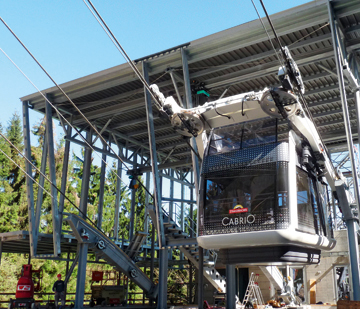
![[Translate to English:] Foto: Leitner](/fileadmin/_processed_/a/8/csm_Vertragsunterzeichnung_Narvik_6_copyright_LEITNER_print_501f2d5c24.jpg)
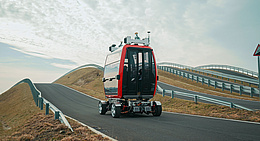
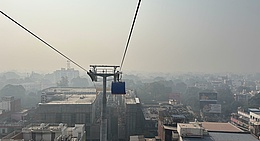
![[Translate to English:] (c) Doppelmayr](/fileadmin/_processed_/b/3/csm_85-ATW_Stechelberg-Muerren_Lauterbrunnen_CHE_001_6442c0520d.jpg)

